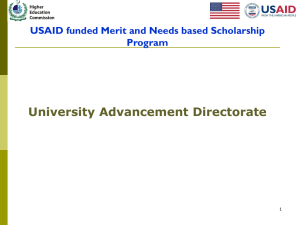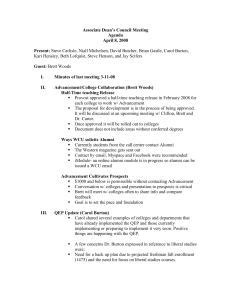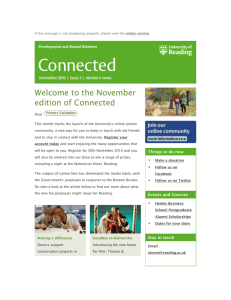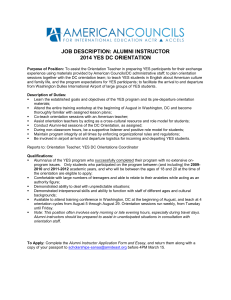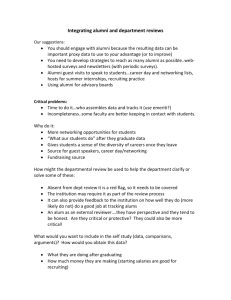Title
advertisement
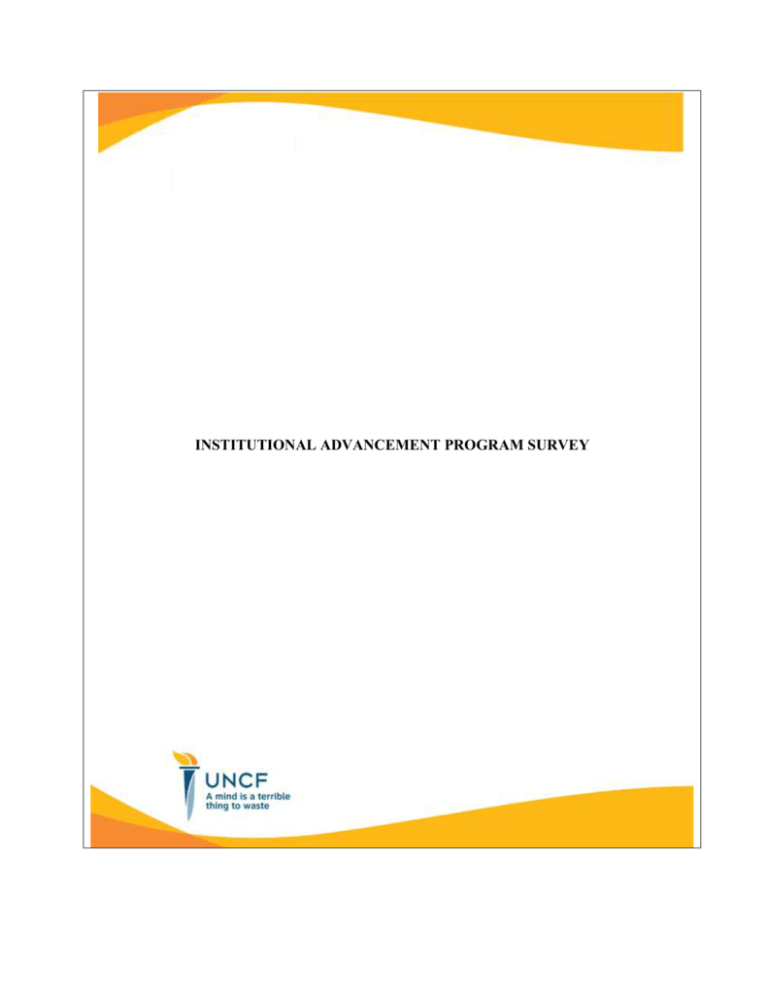
INSTITUTIONAL ADVANCEMENT PROGRAM SURVEY Survey URL: http://www.uncfsp.org/ICB_IAP Suggested Sources for Data: Institutional Advancement Director, Alumni Director, Fund Raising Director, Public Relations Director, University President Total Number of Questions: 42 ICB INSTITUTIONAL ADVANCEMENT INITIATIVE HIGHLIGHT Launched in summer 2006, the HBCU Institutional Advancement Program (IAP) will enhance the advancement capacity of UNCF member institutions with particular emphasis on increasing alumni and trustee giving. Modeled after the successful Kresge HBCU Initiative, IAP will provide ten UNCF member institutions with multi-year grant support of at least $600,000, technical assistance and professional development aid to strengthen their institutional advancement programs. In addition, UNCF will host an annual fundraising training conference—the Advancement Learning Institute—to further advance the fundraising and leadership skills of advancement professionals at all private and public four-year HBCUs nationwide. The Institute will focus on the special challenges facing HBCUs in building successful advancement programs, including issues related to leadership, alumni giving and fundraising. Further, UNCF will sponsor an annual African American Donor’s Reception to honor HBCU alumni who have made generous gifts to their alma maters. The first Institute will be held in November 2007. Ultimately, the HBCU Institutional Advancement Program will help to increase giving, ensure access to state-of-the-art technology for effective and efficient management of advancement functions, support and expand the field of HBCU development professionals and strengthen HBCU leadership as it pertains to institutional advancement and development functions. WHAT IS INSTITUTIONAL ADVANCEMENT? As discussed in Rowland (1986) institutional advancement is defined as a multitude of institutional programs and activities that are intended to promote understanding and support from all its constituencies with the purpose of goal achievement in areas such as students, faculty and income. Institutional Advancement has also been referred to as an aspect of marketing for the university. Buchanan suggests that institutional advancement is really better described as an integrated marketing approach that utilizes all of the organization’s resources to achieve the common goal of creating a successful institution (2000). Fund raising is one aspect of advancement that plays a critical role in the success of most colleges and universities. According to Gasman (2003), “Black colleges need only provide information to increase contributions” (p. 49). The information in this survey will assist in analyzing the strengths and weaknesses of the various HBCU institutional advancement areas which in turn will be passed on to the individual HBCU advancement directors for their strategic use. 2 HOW THE RESULTS WILL BE USED Presently there are no instruments available designed to measure both the needs and strengths in Institutional Advancement at Historically Black Colleges and Universities, (HBCUs). This survey was developed by CAPA and the Institute for Capacity Building, (ICB). The Center for Assessment, Planning and Accountability, (CAPA), is part of the United Negro College Fund Special Programs Corporation, (UNCFSP). The survey was designed to inform ICB on what policies and programs need to be developed to make the HBCUs more successful in their Institutional Advancement, (IA), initiative area. It will be distributed to all HBCUs. The Institutional Advancement survey is a product of ICB, in collaboration with UNCFSP. The instrument was developed with the advice and assistance of UNCF directors, researchers as well as consultants with expertise in the various fields. The Institutional Advancement Survey is designed for use by the Institutional Research Officers. The instructional guide was created to assist the respondents in areas that they may not have expertise. The instrument measures Institutional Advancement factors in five areas: Advancement Management, Staffing and Planning, Institutional Advancement data, Alumni/ae, Public Relations/Marketing Communications (MARCOM), and Sponsored Research. Research officers may need to obtain assistance from professionals in the aforementioned areas in completing this survey. The primary purpose of the Institutional Advancement survey is to provide feedback to ICB for continuous improvement and evaluation purposes. 3 IA SURVEY INSTRUCTIONAL GUIDE WITH EMBEDDED SURVEY QUESTIONS ADVANCEMENT MANAGEMENT Instructions for completing Items 1-7 1. Please select whether the institution has a specific Institutional Advancement (IA) department: Select either yes or no 2. Please answer the following about the chief person who manages the majority of your IA efforts: Please state the items that you have answers to and enter “Unknown” for those you cannot find. 3. The chief officer for the IA functions reports to the: Please select the name of the person the IA officer reports to. 4. Please select whether the institution has formal institutional advancement goals/objectives: Select yes or no. 5. Please select whether the IA chief advancement officer is a member of the institution’s executive officer policy-making group (cabinet): Select yes, no or unknown if unsure. 6. Please select the functions managed by the institution’s IA office. (Select all that Apply) Select all functions that apply and if you do not find a category that matches, select “other”. 7. Please select whether the institution has an organizational membership to CASE (Council for Advancement and Support of Education): Select yes, no, or unknown if unsure. CASE is an international membership association which advances and supports educational institutions. Since there is a fee associated with being a member, you might be able to determine membership by checking with either the IA office or Accounting office in answering this question. ADVANCEMENT MANAGEMENT 1. Please select whether the institution has a specific Institutional Advancement (IA) department: Yes No 2. Please answer the following about the chief person who manages the majority of your IA efforts: Position title: Highest academic degree: Years with institution: Years in present position: Number of years person has been a fundraiser: Gender: The chief officer for the IA functions reports to the: 3. 4 President Vice president Other Unknown 4. Please select whether the institution has formal institutional advancement goals/objectives: Yes No 5. Please select whether the IA chief advancement officer is a member of the institution’s executive officer policymaking group (cabinet): Yes No Unknown 6. Please select the functions managed by the institution’s IA office: (Select all that Apply) Academic advising Physical plant planning Admissions/recruitment Placement Alumni affairs Public Relations and publicity Athletics Publications Church relations Special events Conferences Sponsored Programs/Grants and Contracts Fundraising Title III Government relations Web management Parent programs Other Photo services 7. Please select whether the institution has an organizational membership to CASE (Council for Advancement and Support of Education): Yes No Unknown STAFFING & PLANNING Instructions for completing Items 8-14 8. Please enter the IA Office FTE for the time periods specified. Enter the number of staff for each academic year shown (FTE refers to full time equivalent). 9. Please select the professional consultants the institution has utilized in any of these functions in the last year: (Select all that Apply) Select all consultant types that apply and if you do not find a category that matches, select “other” and name the type of consultant utilized. 10. Please select whether the IA office has a strategic plan: Select yes, no or unknown if unsure. For these purposes, strategic plan refers to any document used by the institution to align its organization and budget structure with organizational priorities, missions, and objectives. 11. Please select whether the IA office has a fundraising plan: Select yes, no or unknown if unsure. 5 12. Please select whether the IA office has fundraising policies and procedures: Select yes, no or unknown if unsure. 13. Please select whether the institution utilizes CASE standards for reporting: Select yes, no or unknown if unsure. 14. Please select whether the institution has a development committee represented on the Board of Trustees: This refers to any type of planning or development committee with representation on the Board. Select yes, no or unknown if unsure. STAFFING & PLANNING 8. Please enter the IA Office FTE for the time periods specified. Academic Year 2005-2006: Academic Year 2006-2007: Academic Year 2007-2008: 9. Please select the professional consultants the institution has utilized in any of these functions in the last year: (Select all that Apply) Admissions/recruitment Alumni affairs Grant Writing Capital Campaign Annual Giving or Annual Fundraising Programs Special Events Public relations Other Unknown 10. Please select whether the IA office has a strategic plan: Yes No Unknown 11. Please select whether the IA office has a fundraising plan: Yes No Unknown 12. Please select whether the IA office has fundraising policies and procedures: Yes No Unknown 13. Please select whether the institution utilizes CASE standards for reporting: Yes No Unknown 6 14. Please select whether the institution has a development committee represented on the Board of Trustees: Yes No Unknown INSTITUTIONAL ADVANCEMENT DATA Instructions for completing Items 15-27 15. Please enter the requested information on the IA Office’s prospect list: Please obtain this information from the IA officer. 16. Please enter the requested information on fundraising from the specified categories for the 2007-2008 Academic Year: Please obtain this information from the IA officer. If a category is not represented in the list, enter the data under appropriate column “other”. 17. For the Academic Year 2007-2008, please state the percentage of funds that were restricted and unrestricted: (Total should add to 100%) Please enter the appropriate percentage for each category 18. Please enter the requested information related to your institution’s last Capital Campaign. If the campaign is current, enter the funds raised to date: Please inquire to the appropriate fundraising office at your institution in completing this answer. 19. Please select whether the institution has a legally separate foundation for the purpose of raising funds: Please inquire to the appropriate fundraising office at your institution in completing this answer. Select yes, no, or unknown. 20. Please select whether the institution’s alumni association operates under a separate 501(c)3: Please inquire to the appropriate alumni office at your institution in completing this answer. Select yes, no, or unknown. 21. Please enter the percent of all $1,000-plus donors in Academic Year 2007-2008: (Total should add to 100%) This question refers to any donor that gave more than a $1,000 to the institution, please enter approximate percentages. 22. Please indicate what percentage of your gift income is generated by each of these sources. (Total should add to 100%)) Please enter approximate percentages and leave blank if item(s) do not apply. 23. Please select the fundraising activities the institution engaged in during the 2007-2008 Academic Year: (Select all that Apply) Please select all fundraising activities that the institution utilizes. 24. Please select the average turn-around time in acknowledging a gift: Select appropriate response. 7 25. Please enter the date of the last market analysis the institution conducted on the donor constituency: Provide the month, date and year that the analysis was completed. Please use the four-digit year (for example, 2008 instead of 08) or enter N/A for non-applicable. 26. Please enter the name of the primary database system the institution uses to track giving to the university: Provide the name of the software system utilized or N/A for non-applicable if the university does not utilize software to track giving. 27. Please enter the number of years the institution has had this system: If you provided a name in Question #26, please enter the number of years the system has been utilized. INSTITUTIONAL ADVANCEMENT DATA 15. Please enter the requested information on the IA Office’s prospect list: Total number of prospects on the prospect list: Total number of prospects that have been researched and qualified: 16. Please enter the requested information on fundraising from the specified categories for the 2007-2008 Academic Year: Percentage Number of Number of Number of Total Largest Change from Gifts New Gifts Renewal Donations Gift in Previous Received Received Gifts in Dollars Dollars Fiscal Year Alumni/ae Trustees Individuals (non-alumni/ae and nontrustees) Corporations Foundations Organizations Parents Faculty Students Other Total 17. For the Academic Year 2007-2008, please state the percentage of funds that were restricted and unrestricted: (Total should add to 100%) Restricted: Unrestricted: 18. Please enter the requested information related to your institution’s last Capital Campaign. If the campaign is current, enter the funds raised to date: Start Date: End Date: 8 Goal: Total Funds Raised: 19. Please select whether the institution has a legally separate foundation for the purpose of raising funds: Yes No Unknown 20. Please select whether the institution’s alumni association operates under a separate 501(c)3: Yes No Unknown 21. Please enter the percent of all $1,000-plus donors in Academic Year 2007-2008: (Total should add to 100%) Percent of $1,000 Plus Donors from: Percent Trustees Corporations Foundations Volunteers President Faculty Staff Students Alumni/ae Other 22. Please indicate what percentage of your gift income is generated by each of these sources in Academic Year 2007-2008: (Total should add to 100%) Percent of Income generated from: Percent Alumni/ae Foundations Parents Businesses Students Churches Trustees Government grants Faculty Estates Other friends Other 23. Please select the fundraising activities the institution engaged in during the 2007-2008 Academic Year: (Select all that Apply) Advertisements Phonathons Alumni Society/Assoc Public Relations Programs Capital Campaign Radio programs/sports Direct Mail Reunion Programs Face-to-Face Solicitations Special Events Homecoming TV programs/sports Internet Other Major Gifts Program 9 24. Please select the average turn-around time in acknowledging a gift: Same day Within 3 working days 4/7 working days More than 8 working days No acknowledgment sent Unknown 25. Please enter the date of the last market analysis the institution conducted on the donor constituency: 26. Please enter the name of the primary database system the institution uses to track giving to the university: 27. Please enter the number of years the institution has had this system: ALUMNI/AE Instructions for completing Items 28-36 28. Please enter the current status of the requested information regarding alumni/ae Please check with alumni or university development office for this information. 29. Please select the phrase that best describes the institution’s alumni/ae association: Select appropriate response. 30. Please enter the number of off-campus alumni meetings the institution conducts annually: Please check with alumni or university development office for this information. 31. Please select whether fundraising is a designated and recognized responsibility of the alumni function: Select yes, no or unknown if unsure. 32. Please select whether the institution has a special alumni program for recent graduates: Select yes, no, or unknown, if the institution has an alumni program specifically dedicated to recent grads. 33. Please enter the percentage of the institution’s total gift support that came from alumni in FY 2007-08: Refer to Alumni answer given in Question #22 when completing this answer; they should represent the same percentage. 34. Please enter the percentage of alumni that made a gift during FY 2007-08: Provide the percentage of alumni that donated a gift out of the total number of alumnae. 35. Please enter the name of the primary database system the institution uses to track alumni/ae data: Provide the software name of alumnae tracking if one is utilized, otherwise enter N/A for non-applicable. 36. Please enter the number of years the institution has had this system: If you provided a name in Question # 35, please enter the number of years the system has been utilized. ALUMNI/AE 28. Please enter the current status of the requested information regarding alumni/ae: Alumni/ae of record Active alumni chapters Number of US States that have active alumni/ae chapters Alumni/ae prospects Alumni/ae prospects who have been screened/qualified for cultivation and solicitation Alumni donors “Lost” alumni 29. Please select the phrase that best describes the institution’s alumni/ae association: Incorporated within the institution with staff supported by the institution’s budget Legally incorporated association that operates independently from the institution The institution does not have an alumni/ae association. 30. Please enter the number of off-campus alumni meetings the institution conducts annually: 31. Please select whether fund raising is a designated and recognized responsibility of the alumni function: Yes No Unknown 32. Please select whether the institution has a special alumni program for recent graduates: Yes No Unknown 33. Please enter the percentage of the institution’s total gift support that came from alumni in FY 2007-08: 34. Please enter the percentage of alumni that made a gift during FY 2007-08: 35. Please enter the name of the primary database system the institution uses to track alumni/ae data: 36. Please enter the number of years the institution has had this system: PUBLIC RELATIONS/MARKETING COMMUNICATIONS Instructions for completing Items 37-39 37. Please select whether the institution has a public relations/marketing communications advisory group comprised of people outside the institution (other than trustees): Select yes, no or unknown if unsure. 38. Please select the entity that has primary responsibility for institutional branding: Select the name of the responsible party or if a category is not represented, select “other”. 39. Please select the last time the institution’s brand was updated. Select the appropriate response. 11 PUBLIC RELATIONS/MARKETING COMMUNICATIONS 37. Please select whether the institution has a public relations/marketing communications advisory group comprised of people outside the institution (other than trustees): Yes No Unknown 38. Please select the entity that has primary responsibility for institutional branding: Board Advancement office President Other 39. Please select the last time the institution’s brand was updated: Less than one year ago 1-5 years ago More than five years ago The institution does not have a specific brand image SPONSORED RESEARCH Instructions for completing Items 40-42 40. Please enter the number of grants or contracts the institution applied for during the 2007-2008 Academic Year: Provide the actual number of grants applied for in the space provided. 41. Please enter the number of grants or contracts the institution was awarded during the 2007-2008 Academic Year: Provide the actual number of grants awarded in the space provided. 42. Please enter the requested information on awarded grants and contracts during the 2007-2008 Academic Year: Provide the dollar amount for the first two items and provide the average number of years for the third item. SPONSORED RESEARCH 40. Please enter the number of grants or contracts the institution applied for during the 2007-2008 Academic Year: 41. Please enter the number of grants or contracts the institution was awarded during the 2007-2008 Academic Year: 42. Please enter the requested information on awarded grants and contracts during the 2007-2008 Academic Year. Largest grant/contract awarded: Smallest grant/contract awarded: Average term of the awarded grants/contracts in terms of years: 12 SUGGESTED READINGS Listed below are sources that will offer further in-depth information on some of the topics in this survey. Many of these sources were utilized to develop the needs assessment. Berry, J.M. (2005). Characteristics of effective philanthropic fundraising at historically black colleges and universities: An analysis of endowment development. Doctoral Dissertation. Union Institute & University, Cincinnati, OH. Bongila, J.P. (2003). Funding strategies for institutional advancement of private universities in the United States: Applications for African/Congolese universities [Electronic version]. Universal-Publishers, 26-77. Retrieved December 17, 2008, from http://books.google.com/books?id=pGa4JlIF12IC&pg=PA28&lpg=PA28&dq=institutional+advancement+ research+literature&source=web&ots=FHpLOfS0sF&sig=5OBE4UCAq3sUYlUcup6qZFo4L9Q&hl=en& sa=X&oi=book_result&resnum=10&ct=result#PPP1,M1 Buchanan, P. McE. (Ed.). (2000). Handbook of institutional advancement third edition. Washington, DC: CASE. CAPA Report. (2008). Institute for Capacity Building, United Negro College Fund. Fiscal year 07+4 survey instruments. Cohen, R.T. (2006). Black college alumni giving: A study of the perceptions, attitudes, and giving behaviors of alumni donors at selected historically black colleges and universities. International Journal of Educational Advancement, 6, 200-221. Council of Independent Colleges Survey. Council for Advancement and Support of Education (CASE). (2006) Retrieved December 17, 2008, from http://www.cic.org/projects_services/coops/CIC_Survey_2006.pdf Fields, C.D. (2001). HBCUs get savvy about fund raising. Black Issues in Higher Education, 18, 38-44. Gasman, M. & Anderson-Thompkins. (2003). Fund raising from black-college alumni: Successful strategies for supporting alma mater. Washington, DC: CASE. Gasman, M. (2000). Charles S. Johnson and Johnnetta Cole: Successful role models for fund-raising at historically black colleges and universities. The CASE International Journal of Educational Advancement, 1, 237-252. Harris-Vasser, D.G. (2003). A comparative analysis of the aspects of alumni giving at public and private historically black colleges and universities. Doctoral Dissertation. Tennessee State University. Institute for Capacity Building, United Negro College Fund. FASTAP consultant initial assessment report. May, C. (2008). Using geographic information systems in institutional advancement. Retrieved December 17, 2008, from http://gis.esri.com/library/userconf/educ08/educ/papers/pap_1050.pdf Oklahoma State University. http://www.osuit.edu/administration/files/InstitutionalAdvancementandMarketing.pdf Reaves, N. (2006). African-American alumni perceptions regarding giving to historically Black colleges and universities. Doctoral Dissertation. North Carolina State University. Rowland, A. W. (1986). Key resources on Institutional Advancement: A guide to the field and its literature. 13 Michigan: Jossey-Bass. Rowland, T.Y. (1997). Institutional advancement initiatives of historically black colleges and universities: A multicase study. Doctoral Dissertation. North Carolina State University. Schulze, B.S. (2003). Changing the odds: Lessons learned from the Kresge initiative. The Kresge Foundation, Troy, MI. Scott. L.V. (2001). A description of successful fund-raising units at public historically black colleges and universities. Doctoral Dissertation. Florida State University. Southern Association for Institutional Research. Retrieved December 17, 2008, from www.sair.org Tindall, N.T.J. (2007). Fund-raising models at public historically black colleges and universities. Public Relations Review, 33, 201-205. Williams, M.G., & Kritsonis, W.A. (2006). Raising more money at the nation’s Historically Black Colleges and Universities. Doctoral Forum: National Journal for Publishing and Mentoring Doctoral Student Research, 3, 1-5. Williams, M.G., & Kritsonis, W.A. (2007). National implications: Why HBCU presidents need entrepreneurial focus. Focus on Colleges, Universities, and Schools, 1, 1-4. Worth, M.J. (2002). New strategies for educational fund raising. Retrieved January 9, 2009, from http://books.google.com/books?id=W0NEhMhisr4C&dq=new+strategies+for+educational+fund+raising+r eference&printsec=frontcover&source=bn&hl=en&sa=X&oi=book_result&resnum=4&ct=result#PPA4,M 14

